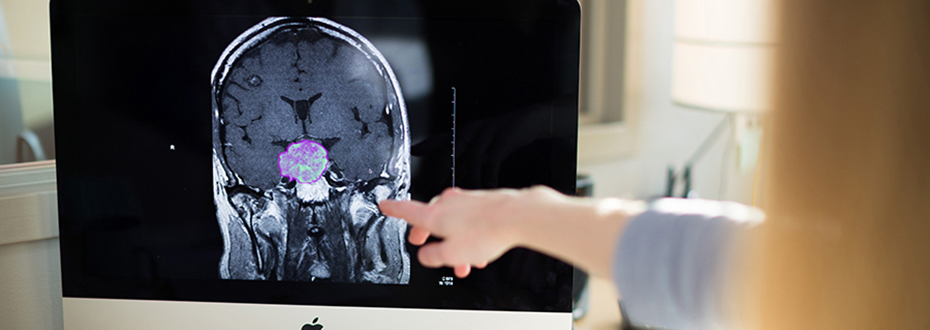Craniopharyngioma

Specialists at the OHSU Pituitary Center offer comprehensive care for craniopharyngiomas, a type of rare brain tumor found above the pituitary gland but below the brain. You’ll find:
- A full team of specialists, with access to brain tumor experts across OHSU.
- The latest surgeries and radiation therapy to treat craniopharyngiomas.
- Skilled neurosurgeons who can remove craniopharyngiomas through the nose, with no visible scar.
Learn more about:
Understanding craniopharyngiomas
What is a craniopharyngioma?
A craniopharyngioma is a slow-growing, noncancerous (benign) brain tumor. Craniopharyngiomas rarely invade nearby tissue, but they can grow large and press on the brain, potentially causing serious problems. Surgery is usually successful in treating them. Scientists don’t know exactly why they form.
Untreated, craniopharyngiomas can:
- Damage the hypothalamus, a gland at the base of the brain that helps control the pituitary gland.
- Interfere with the pituitary gland, a pea-size structure at the base of the brain that is responsible for hormone production.
- Press on optic nerves, damaging vision.
Who gets craniopharyngiomas?
Craniopharyngiomas are rare. Estimates vary, but only a few hundred new cases, at most, are diagnosed in the U.S. each year.
In children: Most craniopharyngiomas are diagnosed in children, usually at age 14 or younger. Learn about the expert care for children’s brain tumors at OHSU Doernbecher Children’s Hospital.
In adults: Craniopharyngiomas also develop in adults, most often in people ages 50 to 74.
Race: These tumors occur more frequently in Black people, though scientists don’t know why.
Outcomes: More than 90% of patients live at least five years after diagnosis.
Symptoms and complications of craniopharyngiomas
Symptoms of craniopharyngiomas vary depending on the tumor’s location. You may have:
- Hormonal problems, which can cause excessive thirst and urination if the tumor affects the pituitary gland.
- Vision problems if the tumor presses on an optic nerve.
- Headache, nausea or vomiting if the tumor puts pressure on the brain.
Craniopharyngiomas can also lead to complications, including:
- Problems controlling body temperature
- Personality changes
- Confusion
- Weight changes
Diagnosing a craniopharyngioma
Exam: To diagnose a craniopharyngioma, we do a physical and neurologic exam, and ask about your symptoms.
Blood tests: These tests measure hormone levels in your blood. High or low levels of hormones may indicate a tumor is pressing on your pituitary gland.
Imaging: An MRI scan can show the presence, size and location of a tumor.
Craniopharyngioma treatment
With proper treatment and follow-up care, symptoms improve and you can lead an active life. Surgery to remove the tumor is often the first treatment. You may need radiation therapy as well. After surgery, most patients have hormone replacement therapy and regular checkups.
Surgery
Our highly skilled neurosurgeons perform more than 100 pituitary and skull base tumor surgeries every year. This large number gives us a high level of expertise.
To remove a craniopharyngioma, we usually use a minimally invasive procedure called transsphenoidal surgery. We access and remove the tumor through the nose. This method leads to a precise surgery, with little or no scarring. It also helps make recovery more comfortable.
Radiation therapy
In about half of patients with craniopharyngiomas, we can remove the entire tumor with surgery. For others, the tumor is difficult to fully remove because it’s growing on or near essential nerves and blood vessels.
In these cases, we may follow surgery with a type of radiation therapy called stereotactic radiosurgery. This treatment aims to prevent the tumor from continuing to grow.
At OHSU, we use the Novalis Tx radiosurgery system, the most advanced equipment available. This system enables us to precisely mold the beams to the shape of the tumor, targeting the tumor while sparing healthy tissue.
Follow-up care
Patients with craniopharyngiomas need ongoing follow-up care because these tumors tend to return, even after surgery. The tumor often returns in the same place. Because of this risk, we monitor you at set schedules after surgery.
At first, you’ll have MRI or CT scans at least once a year. This helps us spot a returning craniopharyngioma early, giving you the best chance of successful treatment. We may need to remove a new tumor through surgery. If your condition is stable, though, you will probably need scans less and less often over time.
You may also need hormone replacement therapy and continued testing of hormone levels.
Learn more
- Craniopharyngioma, Pituitary Network Association
- Craniopharyngioma, National Center for Advancing Translational Sciences
- Craniopharyngioma, National Organization for Rare Disorders
For patients
- Referral: To become a patient, please ask your doctor for a referral.
- Questions: For questions or follow-up appointments, call 503-494-4314.
Location
Parking is free for patients and their visitors.
OHSU Pituitary Center
Center for Health & Healing Building 1
3303 S. Bond Ave.
Portland, OR 97239
Map and directions
Refer a patient
- Refer your patient to OHSU.
- Call 503-494-4567 to seek provider-to-provider advice.
- See more pituitary information for health care professionals.
- OHSU Provider’s Guide to Pituitary Disorders